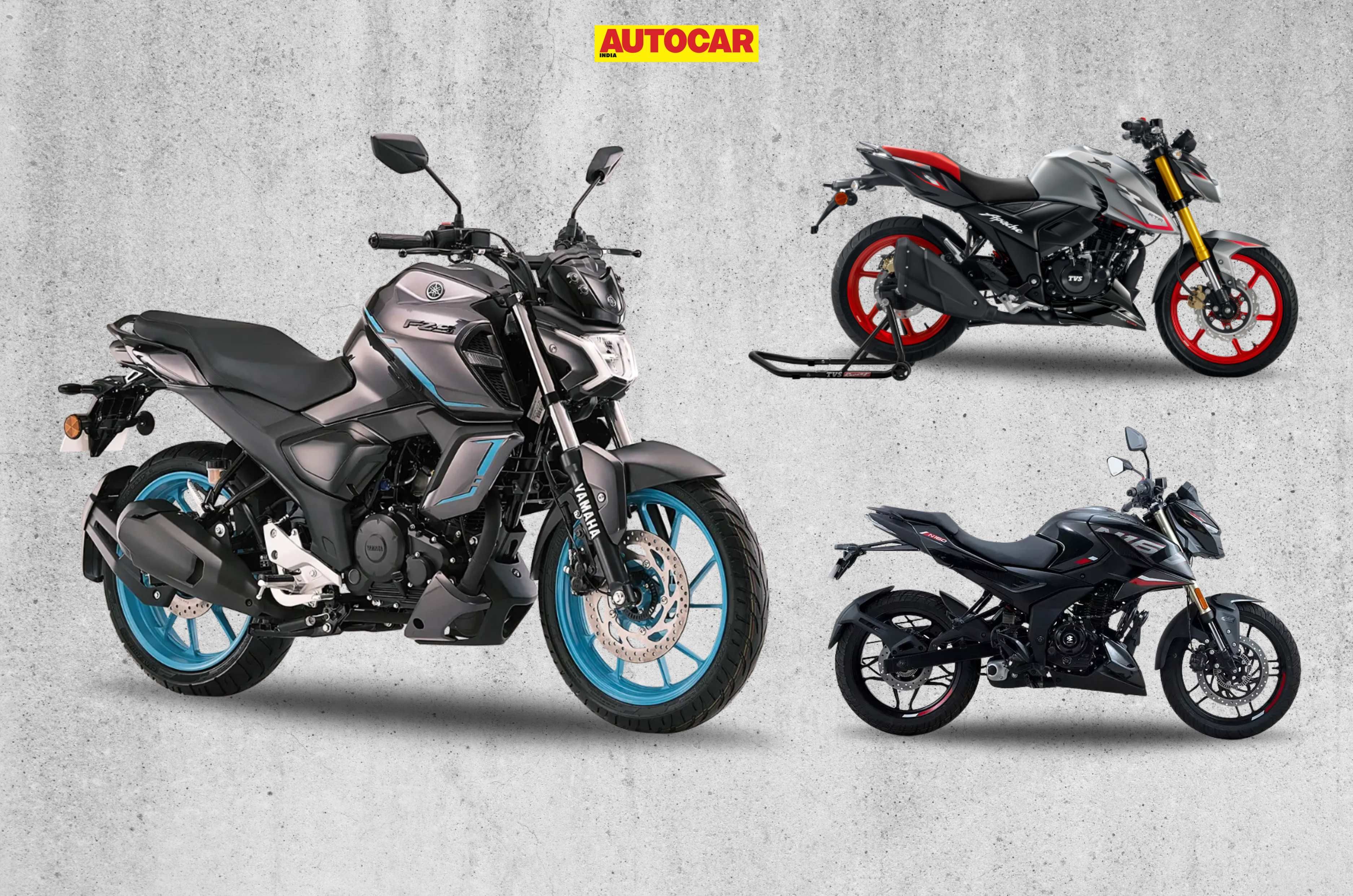Priced at Rs 1.45 lakh, the Yamaha FZ-S Fi Hybrid is the most expensive bike here.
Yamaha has updated the FZ-S Fi with an integrated starter generator, bringing silent starts, an auto start/stop function at idle, and a slight torque assist and the brand claims it improves overall efficiency.
While it may not match the two bikes seen here on outright power, it is priced on par and tries to make up the difference with smart tech for a premium price. But does it justify the extra cost? We’ve stacked it up against its key competitors to see how things look on paper.
Yamaha FZ-S Fi Hybrid vs rivals: Engine and output
| Engine and output | |||
|---|---|---|---|
| Yamaha FZ-S Fi Hybrid | Bajaj Pulsar N160 | TVS Apache RTR 160 4V | |
| Engine | 149cc, single cylinder, air-cooled | 164.8cc, single cylinder, air-cooled | 159.7cc, single cylinder, air/oil-cooled |
| Power | 12.4hp at 7,250rpm | 16hp at 8,750rpm | 17.5hp at 9,250rpm |
| Torque | 13.3Nm at 5,500rpm | 14.6Nm at 6,750 rpm | 14.7Nm at 7500rpm |
| Gearbox | 5-speed | 5-speed | 5-speed |
| Power-to-weight ratio | 89.8hp/tonne | 105hp/tonne | 119.8hp/tonne |
The TVS Apache delivers the highest output
The FZ has the smallest engine in this comparison, and its output figures are modest at best. In contrast, the TVS Apache stands out as the only bike here with an oil-cooled engine, producing the highest power output among its rivals. That said, its torque figures are only marginally higher than the Pulsar’s.
As for the FZ-S Hybrid, Yamaha claims the system provides an electric assist for short durations but it delivers the same torque figure as the standard FZ V4.
Yamaha FZ-S Fi Hybrid vs rivals: Weight and dimensions
| Weight and dimensions | |||
|---|---|---|---|
| Yamaha FZ-S Fi Hybrid | Bajaj Pulsar N160 | TVS Apache RTR 160 4V | |
| Kerb weight | 138kg | 152kg | 146kg |
| Seat height | 790mm | 795 mm | 800mm |
| Ground clearance | 165mm | 165 mm | 180mm |
| Fuel tank capacity | 13 litres | 14 litres | 12 litres |
| Wheelbase | 1330mm | 1348 mm | 1357mm |
The Pulsar N160 is the heaviest
Despite featuring an ISG motor, the FZ-S Hybrid is the lightest motorcycle in this comparison, making it flickable and well-suited to city riding. Its low kerb weight also helps offset its power deficit — at least to some extent.
On the other end of the scale, the Pulsar is the heaviest of the three with the largest fuel tank. The TVS, meanwhile, strikes a well-judged balance — offering the highest power output while sitting between the two in terms of weight.
Yamaha FZ-S Fi Hybrid vs rivals: Suspension, brakes and tyres
| Suspension, brakes and tyres | |||
|---|---|---|---|
| Yamaha FZ-S Fi Hybrid | Bajaj Pulsar N160 | TVS Apache RTR 160 4V | |
| Suspension (F/R) | Telescopic fork / monoshock | Telescopic fork / monoshock | Telescopic fork / monoshock |
| Brakes (F/R) | 282mm disc / 220mm disc | 300mm disc / 230mm disc | 270mm disc / 240mm disc |
| Tyres (F/R) | 100/80-17 / 140/60R17 | 100/80-R17 / 130/70-R17 | 90/90-17 / 130/70 R17 |
The Yamaha FZ-S Hybrid offers the widest rear tyre
In this comparison, both the Pulsar and Apache are represented in their top-spec variants, which come equipped with USD forks. The Yamaha FZ-S Fi Hybrid, on the other hand, is offered in a single trim that sticks with a conventional telescopic fork — with no USD option available at all.
Braking is another area where the FZ-S falls short. While it does get disc brakes at both ends, it misses out on a dual-channel ABS system — a feature offered by its rivals. That said, the Yamaha does feature the widest rear tyre here, similar to the setup on the MT-15.
The Apache has the narrowest front tyre in this test, whereas the Pulsar N160 stands out as the only bike to offer radial tyres at both ends, which should ideally translate to better grip.
Yamaha FZ-S Fi Hybrid vs rivals: Features
The Yamaha is the only one to offer traction control
All three motorcycles come equipped with Bluetooth-enabled instrument consoles. However, the Yamaha FZ-S Fi Hybrid goes a step further by offering a TFT display, while the Pulsar and Apache stick to LCD units. The standout feature on the Yamaha is its Integrated Starter Generator (ISG), which enables silent starts and supports an auto start-stop system that cuts the engine at idle and restarts it when the clutch is pulled or a gear is engaged.
Among the trio, the Bajaj Pulsar N160 is the only one to feature an LED projector headlight compared to the reflector-type LED setups on the Yamaha and TVS. In terms of safety tech, both Bajaj and TVS offer dual-channel ABS. Interestingly, the FZ-S Hybrid is the only one here to feature traction control, but it features only single-channel ABS.
Yamaha FZ-S Fi Hybrid vs rivals: Price
The Yamaha FZ-S Fi is the most expensive bike here
The Yamaha FZ-S Fi Hybrid is the most expensive motorcycle in this comparison — priced around Rs 10,000 more than the standard FZ-S Fi V4. At the other end of the spectrum, the Bajaj Pulsar N160 starts at Rs 1.22 lakh, making it the most affordable. However, its base variant skips out on a USD fork and makes do with single-channel ABS. The TVS Apache RTR 200 4V has a slightly higher starting price than the Pulsar, but its base variant omits a rear disc brake. That said, the higher-spec variants of both the Pulsar and Apache — which offer dual-channel ABS — still manage to undercut the FZ-S Fi Hybrid.
If fuel efficiency and unique features like the ISG system are your priorities, the Yamaha makes a compelling case. But if you’re after a more well-rounded package with better performance and value, the Pulsar and Apache are likely to be more satisfying choices.


